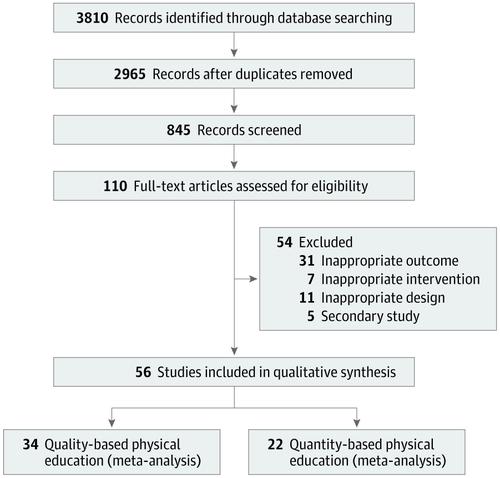当前位置:
X-MOL 学术
›
JAMA Pediatr.
›
论文详情
Our official English website, www.x-mol.net, welcomes your
feedback! (Note: you will need to create a separate account there.)
Association of Physical Education With Improvement of Health-Related Physical Fitness Outcomes and Fundamental Motor Skills Among Youths
JAMA Pediatrics ( IF 24.7 ) Pub Date : 2020-06-01 , DOI: 10.1001/jamapediatrics.2020.0223 Antonio García-Hermoso 1, 2 , Alicia M Alonso-Martínez 3 , Robinson Ramírez-Vélez 1, 3 , Miguel Ángel Pérez-Sousa 4 , Rodrigo Ramírez-Campillo 5 , Mikel Izquierdo 1, 3
JAMA Pediatrics ( IF 24.7 ) Pub Date : 2020-06-01 , DOI: 10.1001/jamapediatrics.2020.0223 Antonio García-Hermoso 1, 2 , Alicia M Alonso-Martínez 3 , Robinson Ramírez-Vélez 1, 3 , Miguel Ángel Pérez-Sousa 4 , Rodrigo Ramírez-Campillo 5 , Mikel Izquierdo 1, 3
Affiliation

|
Importance
Whether quality- or quantity-based physical education (PE) interventions are associated with improvement of health-related physical fitness outcomes and fundamental motor skills (FMSs) in children and adolescents is unknown. Objective
To examine the association of interventions aimed at optimizing PE in terms of quality (teaching strategies or fitness infusion) or quantity (lessons per week) with health-related physical fitness and FMSs in children and adolescents. Data Sources
For this systematic review and meta-analysis, studies were identified through a systematic search of Ovid MEDLINE, Embase, Cochrane Controlled Trials Registry, and SPORTDiscus databases (from inception to October 10, 2019) with the keywords physical education OR PE OR P.E. AND fitness AND motor ability OR skills. Manual examination of references in selected articles was also performed. Study Selection
Studies that assessed the association of quality- or quantity-based PE interventions with improvement in physical fitness and/or FMSs in youths (aged 3-18 years) were included. Data Extraction and Synthesis
Data were processed according to the Preferred Reporting Items for Systematic Reviews and Meta-Analyses (PRISMA) guideline. Random-effects models were used to estimate the pooled effect size (Hedges g). Main Outcomes and Measures
Health-related physical fitness outcomes and FMSs. Results
Fifty-six trials composed of 48 185 youths (48% girls) were included in the meta-analysis. Quality-based PE interventions were associated with small increases in health-related physical fitness (cardiorespiratory fitness [Hedges g = 0.24; 95% CI, 0.16-0.32] and muscular strength [Hedges g = 0.19; 95% CI, 0.09-0.29]) and FMSs (Hedges g = 0.38; 95% CI, 0.27-0.49). Subgroup analyses found stronger associations for quality-based PE interventions on body mass index (Hedges g = -0.18; 95% CI, -0.26 to -0.09), body fat (Hedges g = -0.28; 95% CI, -0.37 to -0.18), cardiorespiratory fitness (Hedges g = 0.31; 95% CI, 0.23-0.39), and muscular strength (Hedges g = 0.29; 95% CI, 0.18-0.39). Quantity-based PE interventions were associated with small increases in only cardiorespiratory fitness (Hedges g = 0.42; 95% CI, 0.30-0.55), muscular strength (Hedges g = 0.20; 95% CI, 0.08-0.31), and speed agility (Hedges g = 0.29; 95% CI, 0.07-0.51). Conclusions and Relevance
The findings suggest that quality-based PE interventions are associated with small increases in both student health-related physical fitness components and FMSs regardless of frequency or duration of PE lessons. Because PE aims to improve more than health, high levels of active learning time may need to be balanced with opportunities for instruction, feedback, and reflection.
中文翻译:

体育教育与改善青少年健康相关体能结果和基本运动技能的协会
重要性 基于质量或数量的体育教育 (PE) 干预是否与改善儿童和青少年健康相关的身体素质结果和基本运动技能 (FMS) 相关尚不清楚。目的检查旨在在质量(教学策略或健身灌输)或数量(每周课程)方面优化体育锻炼的干预措施与儿童和青少年健康相关的身体素质和 FMS 之间的关联。数据来源 对于本系统评价和荟萃分析,通过系统搜索 Ovid MEDLINE、Embase、Cochrane Controlled Trials Registry 和 SPORTDiscus 数据库(从成立到 2019 年 10 月 10 日),使用关键字体育或体育或体育来确定研究和健身和运动能力或技能。还对选定文章中的参考文献进行了人工检查。研究选择研究评估了基于质量或数量的 PE 干预与改善青少年(3-18 岁)体能和/或 FMS 之间的关联。数据提取和综合数据根据系统评价和元分析的首选报告项目 (PRISMA) 指南进行处理。随机效应模型用于估计合并效应大小 (Hedges g)。主要结果和措施 与健康相关的身体健康结果和 FMS。结果 荟萃分析纳入了 56 项试验,其中包括 48 185 名青年(48% 为女孩)。基于质量的 PE 干预与健康相关的身体健康(心肺健康 [Hedges g = 0.24;95% CI,0.16-0. 32] 和肌肉力量 [Hedges g = 0.19; 95% CI,0.09-0.29])和 FMS(对冲 g = 0.38;95% CI,0.27-0.49)。亚组分析发现基于质量的 PE 干预与体重指数(Hedges g = -0.18;95% CI,-0.26 至 -0.09)、体脂(Hedges g = -0.28;95% CI,-0.37 至 - 0.18)、心肺适能(Hedges g = 0.31;95% CI,0.23-0.39)和肌肉力量(Hedges g = 0.29;95% CI,0.18-0.39)。基于数量的 PE 干预仅与心肺适能(Hedges g = 0.42;95% CI,0.30-0.55)、肌肉力量(Hedges g = 0.20;95% CI,0.08-0.31)和速度敏捷性(对冲 g = 0.29;95% CI,0.07-0.51)。结论和相关性 研究结果表明,无论体育课的频率或持续时间如何,基于质量的体育干预都与学生健康相关的身体素质成分和 FMS 的小幅增加有关。由于体育旨在改善健康,因此可能需要在高水平的主动学习时间与指导、反馈和反思的机会之间取得平衡。
更新日期:2020-06-01
中文翻译:

体育教育与改善青少年健康相关体能结果和基本运动技能的协会
重要性 基于质量或数量的体育教育 (PE) 干预是否与改善儿童和青少年健康相关的身体素质结果和基本运动技能 (FMS) 相关尚不清楚。目的检查旨在在质量(教学策略或健身灌输)或数量(每周课程)方面优化体育锻炼的干预措施与儿童和青少年健康相关的身体素质和 FMS 之间的关联。数据来源 对于本系统评价和荟萃分析,通过系统搜索 Ovid MEDLINE、Embase、Cochrane Controlled Trials Registry 和 SPORTDiscus 数据库(从成立到 2019 年 10 月 10 日),使用关键字体育或体育或体育来确定研究和健身和运动能力或技能。还对选定文章中的参考文献进行了人工检查。研究选择研究评估了基于质量或数量的 PE 干预与改善青少年(3-18 岁)体能和/或 FMS 之间的关联。数据提取和综合数据根据系统评价和元分析的首选报告项目 (PRISMA) 指南进行处理。随机效应模型用于估计合并效应大小 (Hedges g)。主要结果和措施 与健康相关的身体健康结果和 FMS。结果 荟萃分析纳入了 56 项试验,其中包括 48 185 名青年(48% 为女孩)。基于质量的 PE 干预与健康相关的身体健康(心肺健康 [Hedges g = 0.24;95% CI,0.16-0. 32] 和肌肉力量 [Hedges g = 0.19; 95% CI,0.09-0.29])和 FMS(对冲 g = 0.38;95% CI,0.27-0.49)。亚组分析发现基于质量的 PE 干预与体重指数(Hedges g = -0.18;95% CI,-0.26 至 -0.09)、体脂(Hedges g = -0.28;95% CI,-0.37 至 - 0.18)、心肺适能(Hedges g = 0.31;95% CI,0.23-0.39)和肌肉力量(Hedges g = 0.29;95% CI,0.18-0.39)。基于数量的 PE 干预仅与心肺适能(Hedges g = 0.42;95% CI,0.30-0.55)、肌肉力量(Hedges g = 0.20;95% CI,0.08-0.31)和速度敏捷性(对冲 g = 0.29;95% CI,0.07-0.51)。结论和相关性 研究结果表明,无论体育课的频率或持续时间如何,基于质量的体育干预都与学生健康相关的身体素质成分和 FMS 的小幅增加有关。由于体育旨在改善健康,因此可能需要在高水平的主动学习时间与指导、反馈和反思的机会之间取得平衡。











































 京公网安备 11010802027423号
京公网安备 11010802027423号